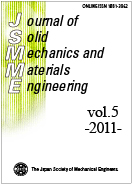All issues
Volume 5, Issue 3
Displaying 1-3 of 3 articles from this issue
- |<
- <
- 1
- >
- >|
Papers
-
Takashi SUMIGAWA, Yujiro KITAGAWA, Takayuki KITAMURA2011 Volume 5 Issue 3 Pages 128-137
Published: 2011
Released on J-STAGE: March 31, 2011
JOURNAL FREE ACCESSIn order to specify the plasticity of a nanoscale Cu component, we develop a novel experimental method by means of a general-purpose transmission electron microscopy (TEM). The characteristic shape of a designed thin specimen, where a Cu film with the thickness of 200 nm is sandwiched by rigid materials (Si substrate and SiN layer), enables us to apply a load near Cu/Si interface edge by an indenter, and prevents buckling due to compressive stress. Continuous in-situ TEM images of the Cu film during deformation are successfully obtained, and the generation and expansion of local plastic region of 10 nm-30 nm are recognized near the Cu/Si interface edge. The yield stress of the plastic region is approximately evaluated to be 200 MPa - 400 MPa, which is close to the one obtained by an inverse analysis under a continuum assumption (272 MPa).View full abstractDownload PDF (2660K) -
Yanbin ZHANG, Tatsuo SAKAI, Kiyoteru MORI2011 Volume 5 Issue 3 Pages 138-150
Published: 2011
Released on J-STAGE: March 31, 2011
JOURNAL FREE ACCESSStatistical fatigue property and fracture mechanism of a Fe-based film amorphous metal, Fe78B13Si9, have been examined in the axial loading. Testing specimens including single-layer and multi-layer types were prepared from a long ribbon of Fe78B13Si9 amorphous metal with dimensions of 25µm in thickness and 50mm in width. The high cycle fatigue tests were performed by using electro-hydraulic servo testing machine in tension-tension loading at a frequency of 50 Hz with the stress ratio of 0.1. The testing data showed that fatigue lives of the amorphous metal had a large scatter, especially at low stress levels. By applying common Weibull distribution and mixed-mode Weibull distribution, the statistic fatigue property of the specimens was quantitatively analyzed. The fatigue strength σ at N=107 was in the range of 135-187 MPa and the fatigue ratio to the tensile strength was found to be σ/σB =6-9%. The fracture surface morphology of failed specimens observed by SEM showed evidently three main regions as follows: 1) flat area corresponding to the crack initiation and the early growth stages up to penetrate the thickness of the film specimen. 2) rough area with a lot of chevron patterns corresponding to the stable propagation as the penetrated fatigue crack. 3) relatively plain area with vein patterns peculiar to the static fracture surface of amorphous metals.View full abstractDownload PDF (1706K) -
Dai-Heng CHEN, Kuniharu USHIJIMA2011 Volume 5 Issue 3 Pages 151-163
Published: 2011
Released on J-STAGE: March 31, 2011
JOURNAL FREE ACCESSIn this paper, the axial crushing behavior of square tubes with grooved surface are studied by using the finite element method. The grooved surface is a dominant factor that influences the deformation mode, and improves the energy absorbing capacity of the square tube. The numerical results show that the average stress of a grooved square tube is affected by the geometry and period of groove. The average stress of the grooved square tube, however, is the same without dependence on width when the geometry and the period of groove are identical. Furthermore, the analysis results of the model predict two modes, called the extensible mode and the inextensible mode, which depend on the aspect ratio. In addition, the average stress predicted by using a master curve and approximation equations for the simple square tube is found to agree well with the results of finite element method analysis.View full abstractDownload PDF (1848K)
- |<
- <
- 1
- >
- >|
